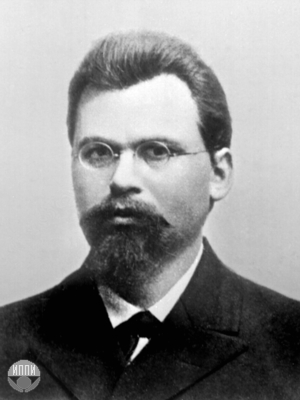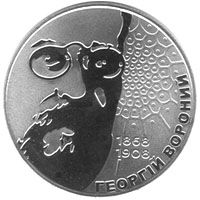Georgy Voronoy facts for kids
Quick facts for kids
Georgy Voronyi
|
|
|---|---|
 |
|
| Born |
Georgy Feodosevich Voronyi (Георгій Феодосійович Вороний)
28 April 1868 Zhuravka, Poltava Governorate, Russian Empire
|
| Died | 20 November 1908 (aged 40) Warsaw, Congress Poland, Russian Empire
|
| Other names | Georgiy Feodosiyovich Voronyi (Георгій Феодосійович Вороний; Russian Empire |
| Alma mater | Saint Petersburg University |
| Known for | Voronoi diagram (Voronyi Tessellation) Voronoi iteration Voronoi formula |
| Scientific career | |
| Fields | Continued fractions |
| Institutions | University of Warsaw |
| Doctoral advisor | Andrey Markov |
| Doctoral students | Wacław Sierpiński Boris Delaunay |
Georgy Feodosevich Voronyi (born April 28, 1868 – died November 20, 1908) was a brilliant mathematician from the Russian Empire. He was of Ukrainian background.
Voronyi is most famous for creating something called the Voronoi diagram. This special diagram helps us understand how space can be divided up. It's used in many cool ways, from computer graphics to understanding weather patterns.
Contents
Early Life and Education
Georgy Voronyi was born in a village called Zhuravka. This village was in the Poltava Governorate of the Russian Empire. Today, this area is part of Ukraine.
In 1889, Voronyi started studying at Saint Petersburg State University. There, he was a student of a famous mathematician named Andrey Markov.
In 1894, he finished his master's degree. His thesis was about special numbers called algebraic integers.
Becoming a Professor
After getting his master's degree, Voronyi became a professor. He started teaching at the University of Warsaw in the same year, 1894.
He continued his studies and defended his doctoral thesis in 1897. This advanced work was about continued fractions, which are special ways to write numbers.
Voronyi was so respected that he was invited to speak at a big meeting of mathematicians. This was the International Congress of Mathematicians in 1904.
A Dedicated Mathematician
Sadly, Georgy Voronyi faced health problems when he was only 40 years old. He had stomach issues that made it hard for him to work.
He wrote in his diary about his struggles. He said he was making great progress with his math work. But at the same time, his health was getting worse.
He worried that his hard-earned discoveries might be lost if he couldn't finish them. He passed away on November 20, 1908, after a severe illness.

Voronoi Diagrams and Their Uses
Voronyi introduced the idea of what we now call Voronoi diagrams. You might also hear them called Voronoi tessellations.
Imagine you have a bunch of points scattered on a map. A Voronoi diagram divides the map into regions. Each region belongs to the closest point.
These diagrams are super useful in many areas of science. They help analyze data that is spread out in space.
For example, they are used in geophysics (studying Earth), meteorology (weather), and even in condensed matter physics (how materials behave).
Voronoi diagrams are also very popular in computer graphics. They help create cool effects in architecture, movies, and video games.
Some software, like Blender 3D, uses Voronoi patterns. These patterns can make random textures for different uses in digital art.
Voronyi's Lasting Impact
Georgy Voronyi taught many students who became important mathematicians. One of his students was Wacław Sierpiński. Sierpiński is famous for the Sierpiński triangle.
Another mathematician, Boris Delaunay, was also greatly influenced by Voronyi. Delaunay is known for something called Delaunay triangulation, which is related to Voronoi diagrams.
In 2008, Ukraine honored Voronyi by releasing a special coin. It was a two-hryvnia coin. This coin celebrated 100 years since his death.
Voronyi's family also had notable members. His son, Yuriy Voronyi, became a famous surgeon. He performed the world's first human-to-human kidney transplant in 1933. His daughter, Mariia Vorona-Vasylenko, became a Ukrainian language teacher.
See also
 In Spanish: Gueorgui Voronói para niños
In Spanish: Gueorgui Voronói para niños
- Bowyer–Watson algorithm
- Centroidal Voronoi tessellation
- Delaunay triangulation
- Fortune's algorithm
- Laguerre–Voronoi diagram
- Voronoi deformation density
- Voronoi formula
- Voronoi iteration
- Voronoi pole
- Weighted Voronoi diagram
- Wigner–Seitz cell

